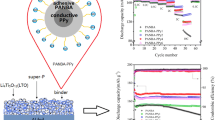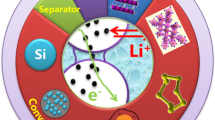Abstract
In this paper, an acrylate-modified binder is introduced to the negative electrode of a power battery to improve its fast-charging performance. The Li+ ionic conductivity of the acrylated-modified GD1346 copolymer was twice that of commercial SN307 copolymer at room temperature. GD1346 greatly reduced the Ohm resistance and charge transfer resistance of the negative electrode from those of SN307 and enhanced the surface potential to more than 15 mV. This high performance is attributed to strong electrolyte adsorption ability and the ester groups, which favour Li+ diffusion. Consequently, the fast-charging time of the power battery is reduced from 107 to 82 min as the state of charge increases from 0 to 100%. The practicality of acrylate-modified GD1346 binder in the manufacture of large-scale batteries is also confirmed. The techniques developed in this work are expected to promote the development of efficient binders for next-generation high-energy lithium ion batteries.
Graphical abstract
















Similar content being viewed by others
Data availability
The data supporting the findings in this article are available within the article.
References
Nitta N, Wu F, Lee JT, Yushin G (2015) Li-ion battery materials: present and future. Mater Today 18:252–264. https://doi.org/10.1016/j.mattod.2014.10.040
Zhang L, Zhu C, Yu S, Ge D, Zhou H (2022) Status and challenges facing representative anode materials for rechargeable lithium batteries. J Energy Chem 66:260–294. https://doi.org/10.1016/j.jechem.2021.08.001
Tarascon JM, Armand M (2001) Issues and challenges facing rechargeable lithium batteries. Nature 414:359–367. https://doi.org/10.1038/35104644
Afshar S, Macedo P, Mohamed F, Disfani V (2021) Mobile charging stations for electric vehicles—a review. Renew Sust Energ Rev 152:111654. https://doi.org/10.1016/j.rser.2021.111654
Giansoldati M, Monte A, Scorrano M (2020) Barriers to the adoption of electric cars: evidence from an Italian survey. Energy Policy 146:111812. https://doi.org/10.1016/j.enpol.2020.111812
Hu J, Fan F, Zhang Q, Zhong S, Ma Q (2022) Effects of long-term fast charging on a layered cathode for lithium-ion batteries. J Energy Chem 44:604–612. https://doi.org/10.1016/j.jechem.2021.10.030
Li Y, Gao X, Feng X, Ren D, Li Y, Hou J, Wu Y, Du J, Lu L, Ouyang M (2022) Battery eruption triggered by plated lithium on an anode during thermal runaway after fast charging. Energy 239:122097. https://doi.org/10.1016/j.energy.2021.122097
Yang Z, Morrissette JW, Meisner Q, Son SB, Trask SE, Tsai Y, Lopykinski S, Naik S, Bloom I (2021) Extreme fast-charging of lithium-ion cells: effect on anode and electrolyte. Energy Technol 9:2000696. https://doi.org/10.1002/ente.202000696
Yang XG, Zhang G, Ge S, Wang CY (2018) Fast charging of lithium-ion batteries at all temperatures. PNAS 115:7266–7271. https://doi.org/10.1073/pnas.1807115115
Xie W, Liu X, He R, Li Y, Gao X, Li X, Peng Z, Feng S, Feng X, Yang S (2020) Challenges and opportunities toward fast-charging of lithium-ion batteries. J Energy Storage 32:101837. https://doi.org/10.1016/j.est.2020.101837
He Y, Song Z, Liu Z (2019) Fast-charging station deployment for battery electric bus systems considering electricity demand charges. Sustain City Soc 48:101530. https://doi.org/10.1016/j.scs.2019.101530
Liu T, Ge S, Yang XG, Wang CY (2021) Effect of thermal environments on fast charging Li-ion batteries. J Power Source 511:230466. https://doi.org/10.1016/j.jpowsour.2021.230466
Kim DS, Kim YE, Kim H (2019) Improved fast charging capability of graphite anodes via amorphous Al2O3 coating for high power lithium ion batteries. J Power Sources 422:18–24. https://doi.org/10.1016/j.jpowsour.2019.03.027
Hu J, Zhong S, Yan T (2021) Using carbon black to facilitate fast charging in lithium-ion batteries. J Power Source 508:230342. https://doi.org/10.1016/j.jpowsour.2021.230342
Li L, Zhang D, Deng J, Gou Y, Fang J, Cui H, Zhao Y, Cao M (2021) Carbon-based materials for fast charging lithium-ion batteries. Carbon 183:721–734. https://doi.org/10.1016/j.carbon.2021.07.053
Zhang H, Yang Y, Ren D, Wang L, He X (2021) Graphite as anode materials: fundamental mechanism, recent progress and advances. Energy Storage Mater 36:147–170. https://doi.org/10.1016/j.ensm.2020.12.027
Jang D, Suh S, Yoon H, Kim J, Kim H, Baek J, Kim HJ (2021) Enhancing rate capability of graphite anodes for lithium-ion batteries by pore-structuring. Appl Surf Sci 6:10068. https://doi.org/10.1016/j.apsadv.2021.100168
Han H, Park H, Kil KC, Jeon Y, Ko Y, Lee C, Kim M, Cho CW, Kim K, Paik U, Song T (2015) Microstructure control of the graphite anode with a high density for Li ion batteries with high energy density. Electrochim Acta 166:367–371. https://doi.org/10.1016/j.electacta.2015.03.037
Tomaszewska A, Zhu Z, Feng X, O’Kane S, Liu X et al (2019) Lithium-ion battery fast charging: a review. eTransportation 1:100011. https://doi.org/10.1016/j.etran.2019.100011
Frankenberger M, Singh M, Dinter A, Jankowksy S, Schmidt A, Pettinger KH (2019) Laminated lithium ion batteries with improved fast charging capability. J Electroanal Chem 837:151–158. https://doi.org/10.1016/j.jelechem.2019.02.030
Wang Q, Jiang L, Yu Y, Sun J (2019) Progress of enhancing the safety of lithium ion battery from the electrolyte aspect. Nano Energy 55:93–114. https://doi.org/10.1016/j.nanoen.2018.10.035
Zeng Y, Chalise D, Lubner SD, Kaur S, Prasher RS (2021) A review of thermal physics and management inside lithium-ion batteries for high energy density and fast charging. Energy Storage Mater 41:264–288. https://doi.org/10.1016/j.ensm.2021.06.008
Wassiliadis N, Schneider J, Frank A, Wildfeuer L, Lin X, Jossen A, Lienkamp M (2021) Review of fast charging strategies for lithium-ion battery systems and their applicability for battery electric vehicles. J Energy Storage 44(part B):103306. https://doi.org/10.1016/j.est.2021.103306
Li Y, Li K, Xie Y, Liu B, Liu J, Zheng J, Li W (2021) Optimization of charging strategy for lithium-ion battery packs based on complete battery pack model. J Energy Storage 37:102466. https://doi.org/10.1016/j.est.2021.102466
Mathieu R, Briat O, Gyan P, Vinassa JM (2021) Fast charging for electric vehicles applications: numerical optimization of a multi-stage charging protocol for lithium-ion battery and impact on cycle life. J Energy Storage 40:102756. https://doi.org/10.1016/j.est.2021.102756
Lin X, Wang S, Kim Y (2019) A framework for charging strategy optimization using a physics-based battery model. J Appl Electrochem 49:779–793. https://doi.org/10.1007/s10800-019-01322-1
Katzer F, Danzer MA (2021) Analysis and detection of lithium deposition after fast charging of lithium-ion batteries by investigating the impedance relaxation. J Power Source 503:230009. https://doi.org/10.1016/j.jpowsour.2021.230009
Koseoglou M, Tsioumas E, Ferentinou D, Jabbour N, Papagiannis D, Mademlis C (2021) Lithium plating detection using dynamic electrochemical impedance spectroscopy in lithium-ion batteries. J Power Source 512:230508. https://doi.org/10.1016/j.jpowsour.2021.230508
Petzl M, Danzer A (2021) Nondestructive detection, characterization and quantification of lithium plating in commercial lithium-ion batteries. J Power Sources 254:80–87. https://doi.org/10.1016/j.jpowsour.2013.12.060
Chen H, Ling M, Hencz L, Ling HY, Li G, Lin Z, Liu G, Zhang S (2018) Exploring chemical, mechanical and electrical functionalities of binders for advanced energy-storage devices. ACS Chem Rev 118:8936–8982. https://doi.org/10.1021/acs.chemrev.8b00241
Nirmale TC, Kale BB, Varma AJ (2017) A review on cellulose and lignin based binders and electrodes: small steps towards a sustainable lithium ion battery. Int J Biol Macromol 103:1032–1043. https://doi.org/10.1016/j.ijbiomac.2017.05.155
Chen L, Xie X, Xie J, Wang K, Yang J (2006) Binder effect on cycling performance of silicon/carbon composite anodes for lithium ion batteries. J Appl Electrochem 36:1099–1104. https://doi.org/10.1007/s10800-006-9191-2
Lestriez B (2010) Functions of polymers in composite electrodes of lithium ion batteries. C R CHIM 13:1341–1350. https://doi.org/10.1016/j.crci.2010.01.018
Zhang Z, Zeng T, Lai Y, Jia M, Li J (2014) A comparative study of different binders and their effects on electrochemical properties of LiMn2O4 cathode in lithium ion batteries. J Power Sources 247:1–8. https://doi.org/10.1016/j.jpowsour.2013.08.051
Koo B, Kim H, Cho Y, Lee KT, Choi NS, Cho J (2012) A highly cross-linked polymeric binder for high-performance silicon negative electrodes in lithium ion batteries. Angew Chem 51:8892–8897. https://doi.org/10.1002/ange.201201568
Qiu L, Shao Z, Wang D, Wang F, Wang W, Wang J (2014) Carboxymethyl cellulose lithium (CMC-Li) as a novel binder and its electrochemical performance in lithium-ion batteries. Cellulose 21:2789–2796. https://doi.org/10.1007/s10570-014-0274-7
Wei L, Chen C, Hou Z, Wei H (2016) Poly (acrylic acid sodium) grafted carboxymethyl cellulose as a high performance polymer binder for silicon anode in lithium ion batteries. Sci Rep 6:19583. https://doi.org/10.1038/srep19583
Wang Z, Huang T, Liu Z, Yu A (2021) Dopamine-modified carboxymethyl cellulose as an improved aqueous binder for silicon anodes in lithium-ion batteries. Electrochim Acta 389:138806. https://doi.org/10.1016/j.electacta.2021.138806
Liu Z, Han S, Xu C, Luo Y, Peng N, Qin C, Zhou M, Wang W, Chen L, Okada S (2016) In situ crosslinked PVA–PEI polymer binder for long-cycle silicon anodes in Li-ion batteries. RSC Adv 6:68371–68378. https://doi.org/10.1039/C6RA12232A
Shi Y, Peng L, Ding Y, Zhao Y, Yu G (2015) Nanostructured conductive polymers for advanced energy storage. RSC Chem Soc Rev 44:6684–6696. https://doi.org/10.1039/C5CS00362H
Nguyen MHT, Oh ES (2013) Application of a new acrylonitrile/butylacrylate water-based binder for negative electrodes of lithium-ion batteries. Electrochem Commun 35:45–48. https://doi.org/10.1016/j.elecom.2013.07.042
Kaneko M, Nakayama M, Wakihara M (2007) Lithium-ion conduction in elastomeric binder in Li-ion batteries. J Solid State Electrochem 11:1071–1076. https://doi.org/10.1007/s10008-006-0239-3
Wang C, Xing Y, Xia Y, Zhang R, Wang S, Shi K, Tan J, Gui X (2021) Investigation of interactions between oxygen-containing groups and water molecules on coal surfaces using density functional theory. Fuel 287:119556. https://doi.org/10.1016/j.fuel.2020.119556
Kim SE, Jeong SK, Park KT, Lee KY, Kim HJ (2021) Effect of oxygen-containing functional groups in metal-free carbon catalysts on the decomposition of methane. Catal Commun 148:106167. https://doi.org/10.1016/j.catcom.2020.106167
Zhang S, Wang Z, Guo B, Xu J (2021) Secondary nucleation in polymer crystallization: a kinetic view. Polym Cryst 4:10173. https://doi.org/10.1002/pcr2.10173
Zin MRM, Mahendrasingam A, Konkel C, Narayanan T (2021) Effect of D-isomer content on strain-induced crystallization behaviour of poly(lactic acid) polymer under high speed uniaxial drawing. Polymer 216:123422. https://doi.org/10.1016/j.polymer.2021.123422
Heinze D, Mang T, Popescu C, Weichold O (2016) Effect of side chain length and degree of polymerization on the decomposition and crystallization behaviour of chlorinated poly(vinyl ester) oligomers. Thermochim Acta 637:143–153. https://doi.org/10.1016/j.tca.2016.05.015
Dees DW, Jansen AN, Abraham DP (2007) Theoretical examination of reference electrodes for lithium-ion cells. J Power Sources 174:1001–1006. https://doi.org/10.1016/j.jpowsour.2007.06.128
Huang J, Ge H, Li Z, Zhang J (2015) Dynamic electrochemical impedance spectroscopy of a three-electrode lithium-ion battery during pulse charge and discharge. Electrochim Acta 176:311–320. https://doi.org/10.1016/j.electacta.2015.07.017
Heubner C, Langklotz U, Schneider M, Michaelis A (2015) Analysis of the counter-electrode potential in a 3-electrode lithium ion battery cell. J Electroanal Chem 759:91–94. https://doi.org/10.1016/j.jelechem.2015.10.037
Wang H, Zhu Y, Kim SC, Pei A, Li Y, Boyle DT, Wang H, Zhang Z, Ye Y, Huang W, Liu Y, Xu J, Li J, Liu F, Cui Y (2020) Underpotential lithium plating on graphite anodes caused by temperature heterogeneity. PNAS 117:29453–29461. https://doi.org/10.1073/pnas.2009221117
Funding
The authors acknowledge financial support from the State Key Laboratory of Advanced Technologies for comprehensive Utilisation of platinum Metals (No.SKL-SPM-202003) and Foshan Science and Technology Innovation Project (NO. 1920001004360).
Author information
Authors and Affiliations
Corresponding author
Ethics declarations
Conflict of interest
Authors have no conflicts of interest to declare.
Additional information
Publisher's Note
Springer Nature remains neutral with regard to jurisdictional claims in published maps and institutional affiliations.
Rights and permissions
Springer Nature or its licensor (e.g. a society or other partner) holds exclusive rights to this article under a publishing agreement with the author(s) or other rightsholder(s); author self-archiving of the accepted manuscript version of this article is solely governed by the terms of such publishing agreement and applicable law.
About this article
Cite this article
Zhou, Q., Liu, F., Wen, B. et al. Acrylate-modified binder for improving the fast-charging ability of a power battery. J Appl Electrochem 53, 257–270 (2023). https://doi.org/10.1007/s10800-022-01773-z
Received:
Accepted:
Published:
Issue Date:
DOI: https://doi.org/10.1007/s10800-022-01773-z




